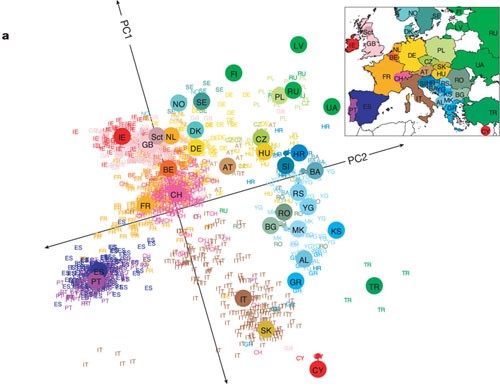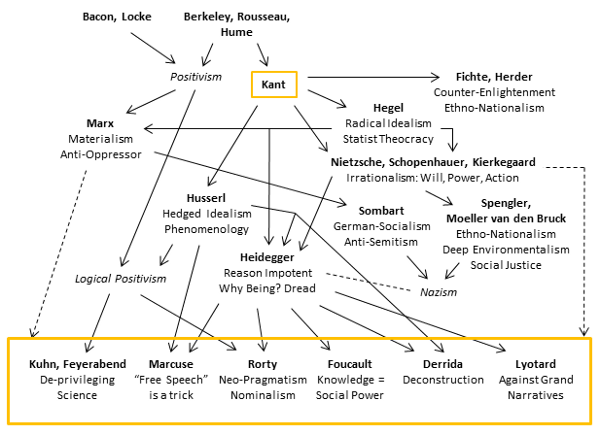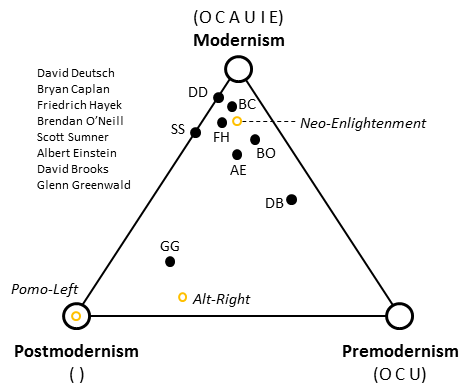More On: Centrism
Not Centrism, but Universalism
The term 'centrism' refers to an ideological middle ground between the extremes of today's left and right. However, the dichotomy between centrism and radicalism fails to capture important distinctions. To find them, you'll have to go further into Western intellectual history.
Let's start with some real-life examples of "centrism." Intellectuals including Sam Harris, Steven Pinker, George Will, Maajid Nawaz, Scott Alexander, Christina Hoff Sommers, Christopher Hitchens, and Bret Stephens are examples of 'neo-Enlightenment' thinkers. And these ideas can be traced back to essential Enlightenment principles, which are currently under attack from both the left and right.
Left-wing anti-Enlightenment beliefs are surfacing in the form of academic speech restrictions, increased tolerance of violence in "anti-fascist" and "anti-racist" rallies, and rhetorical methods that target opponents' racial or sexual characteristics rather than their ideas.
Likewise, from the right: economic protectionism, scapegoating of foreigners, conspiracy theories, and explicit neo-Nazism.
What’s wrong with the centrism-extremism lens on these three camps (e.g., as ably outlined here)? Centrism is said to be a “consistent philosophical system” based on the idea that “progress is best achieved by caution, temperance, and compromise, not extremism, radicalism, or violence.” Centrism is for constitutionalism over identity politics and absolutism. And it eschews “grand theories” whether of the altruistic-authoritarian or extreme-libertarian variety, in favor of a more “pragmatic” issue-by-issue analysis, rooted in science and evidence.
How does a key concept of moderation justify any of these claims? There isn't a clear definition of what moderation is in this context. There's just a nagging feeling that, whatever our culture's majority ideas are, centrism is somewhere in the middle, sufficiently removed from what insane individuals with crass posters or frog memes believe. But what is the significance of our culture? Indeed, why is it that educated cosmopolitans have their own subculture rather than fly-over radio stations or intersectional poetry jams?Just ask George III. The American founders were revolutionaries, not moderates. Of course, Mao was as well. The argument is that we need a strong ideological criterion to distinguish good from poor revolutions, which centrism lacks. Alternatively, positive absolutisms (such as free speech) can be distinguished from poor absolutisms (like papal infallibility or the dogma that the sexes are psychologically indistinguishable).Also, defining a philosophical system on the plain, pragmatic foundation of science and evidence, since that's what works, not lofty ideas - it's been tried. It was dubbed "pragmatism," and it came to a halt at the epistemological dead end of rejecting the fundamental idea of "truth" (insofar as "truth" refers to mental objects that correspond to external reality). Richard Rorty was the product of pragmatism. But, wait a minute, let's go back down that road.
How can we discover a proper taxonomy if centrism-extremism doesn't give one? Biology provides us with a framework. Richard Dawkins' famous discovery here is to conceive of ideas — "memes" in the wide sense, as he coined the term — as the genetic units of our continually shifting belief systems, mutating and reproducing like DNA.
When scientists discovered the molecular process of heredity and mutation through DNA, it opened up a whole new field of research. They might sequence (partial) genomes from hundreds of people and then use the statistical approach of Principal Components Analysis to conduct extensive, quantitative research on genetic similarities and differences (PCA). Below is an example of the findings of using PCA in a survey of 3000 European respondents. It finds two primary axes (PCs) of genetic variation among these individuals, allowing you to visualize them all on a two-dimensional map.

The process of deciphering genetic coding is a meticulous and scientific one. What is the best way to sequence a memetic code? We're in the shoes of biologists who worked before the structure of DNA was discovered. They realized there had to be some kind of hereditary process, but they couldn't quantify it in people yet.
Sequencing the Memome
Memetic codes have a complex hierarchical structure and are more dynamic in mutation than genetic codes, which are merely linear streams of information. This is going to be crucial.Almost every heritable genetic alteration takes place in a single shot when sperm hits egg. After then, your genetic code is essentially set for the rest of your life. Your memetic code, on the other hand, is continually evolving throughout your life as you analyze and update your own thoughts in complex non-linear ways. (This article, like any other, is attempting to persuade you to do so!)In other words, the potential of human reason to reshape the complex structure of people's beliefs in real time is the main distinction between biological and cultural development. This explains why cultural evolution is more faster than biological evolution. And here's a hint as to which concepts are most vital for cultural evolution: ideas that govern the activity of reason itself - ideas about ideas.
Certain profound attitudes about reason are ingrained in the extreme left. The hard right feels the same way. The budding neo-Enlightenment movement shares this sentiment. How do they differ from one another?
On the left we see the rise of micro-aggression and triggering theories founded on the idea that language is a game not a quest for truth. So if your team plays mean don’t try to justify it by saying your game is “true.” Campus speech codes: needed to rebalance power relations, which is what matters — not “truth” as filtered through your white consciousness. Oh now you are being oppressed by leftist authoritarianism, which violates your Enlightenment values? Stop logic-splaining to us! That’s just a meta-narrative you have constructed to deflect what we’re trying to tell you. Listen! Stop gesturing! So what if we roughed up that racist speaker while he was trying to escape our mob? He was here spewing white supremacist eugenics from his book on rural, white drug addicts and their dangerous cognitive deficits. “Free speech”!? Thomas Jefferson raped his slaves!
These slogans and intellectual norms did not spring spontaneously from the minds of twenty year-old college students. There is a clear and by now well known link between their professors’ ideas and the mid-20th century philosophical movement of postmodernism. Some key figures and theses:
- Michel Foucault reduces what the West had regarded as rationally derived knowledge to a means of power over the oppressed.
- Jacques Derrida gives us the deconstructionist language game, in which no objective meaning need be sought in a text. It’s all oppressor-speak.
- Jean-Francois Lyotard tells us to discard Enlightenment “meta-narratives” about human progress, which are just masks for the exercise of power.
- Thomas Kuhn turns the long arc of scientific progress into a geeky popularity contest. Paul Feyerabend adds that, epistemically, it might just as well have been a contentious game of D&D.
- Herbert Marcuse edifies us that ideas like “free speech” are merely a ruse performed by rich oppressors to trick the working class into subservience.
Perhaps the best single, compact resource here is Stephen Hicks’ Explaining Postmodernism. The present account is patterned on his essentialized dive into the deep origins of postmodernist ideas.
So, where did these concepts originate? Marx is responsible for the constant focus on the underprivileged. As the Soviet Union was revealed in the 1950s, postmodernists were virtually all staunch socialists left holding the bag. Their relativism provided a handy way out of the situation.However, one early twentieth-century German philosopher was the father of virtually the whole postmodernist family. Martin Heidegger saw man as afflicted by the inability of reason to resolve profound riddles such as: Why does the cosmos exist at all? Why not simply leave it at that? Because reason is incapable of comprehending such questions, our only option is to embrace terror, shame, and dread as our natural state in the face of an incomprehensible Being.Heidegger was reacting to his phenomenological heritage and his master Edmund Husserl. Phenomenology had shyly avoided metaphysical concerns by focusing solely on the pure activities of consciousness, without regard for their relationship to a fictitious external reality.
Unsurprisingly, Heidegger and the postmodernists were influenced by Nietzsche, Schopenhauer, and Kierkegaard's blatant irrationalism. They all agreed on the phenomenological premise that there is no objective method to link rational mind to external things. However, they sought a purported deeper connection to reality by pure acts of will — that is, through feelings rather than intellect.And it's here that we meet some of the current left's and right's shared forefathers. The alt-right, which is gaining traction today, is a newer movement with more shaky underpinnings. However, one important theory is a racialist power-struggle metaphysics similar to that popular among early twentieth-century German-socialist intellectuals who portrayed Aryans in the Marxian role of oppressed. Heidegger was a well-known supporter of National Socialism (Nazism). Other lines of influence from Nazism may be traced back to intellectuals like Spengler and Moeller van den Bruck, both of whom were influenced by Nietzsche and the other irrationalists.
Even further back, Georg Hegel, who inspired both Marx and the irrationalists, may be found. The objectivity problem (the broken link between mental representations and external reality) was addressed by Hegel's philosophical idealism by simply rejecting the existence of such a mind-independent reality. The issue has been resolved!
Looking over all these strands of thought, the objectivity problem stands out as a shared premise underlying all the factions — from Hegel to Heidegger and beyond. One can observe the objectivity problem already starting to surface mid-Enlightenment with George Berkeley and David Hume. But their main influence was just to raise questions. The hands shaping the West’s ultimate answers, according to Hicks, were those of Immanuel Kant. I have illustrated this grand narrative in the below diagram.

Kant’s critical innovation was the idea that rational consciousness is by nature distortive — cut off from “things-in-themselves,” the true, undistorted objects of reality that constitute a separate “noumenal” realm. Man can only access the “phenomenal” realm in which he, as a mortal being, is incapable of distinguishing between what comes from the true nature of things and what comes from the distortive lens of his reason. Kant explicitly named the motivation for his system: to save the innocent claims of religion from Enlightenment predators. Nevertheless, he formulated it as a secular, logical critique of reason from within, aimed to subvert the predators by their own claws.
There is debate among academics regarding whether Kant was a fundamentally anti-rational force. What's crucial here is the underlying logic of Kant's main philosophical invention (reason-as-distortive) and its explosive repetition throughout the nineteenth century, rather than an overall assessment of Kant's ideas.This shattered the Enlightenment balance that existed before Kant. Different adaptation schemes arose as a result of the necessity to adjust surrounding ideas: idealism, phenomenology, and irrationalism. As we've seen, each of them developed its own intellectual lineages, which eventually merged into postmodernism.
Principal Components of the Mind
Consider the above as our sequenced memome data. Now it’s time for PCA. Hicks gives us a lead by defining five essential aspects of reason — principal components, if you will:
- Objectivity: reason is not inherently distortive
- Competence: it is capable of comprehending reality
- Autonomy: it’s not subordinate to other means of knowing
- Universality: it applies to all areas of inquiry and all inquirers
- Individuality: it is an attribute of a single mind, not a tribe
To which let’s add:
- Emergence: it can be coordinated between minds without a central plan
(This is meant in the broad Hayekian sense of spontaneous orders arising under certain systems of economic and/or memetic exchange). Hicks also splits post-ancient Western history into three major intellectual eras: the premodern, modern, and postmodern — roughly corresponding to the Middle Ages, Enlightenment, and recent continental scene. I would isolate the aspects of reason strongly affirmed in each era as follows:
- Premodern: (O C U)
- Modern: (O C A U I E)
- Postmodern: ( )
Indeed, each man's or movement's philosophy can be broken down into our six PCs and then compared to these three groups. It's worth noting that the centrism-extremism axis is absent from this fine-grained image. (This axis may be interpreted mathematically as lying roughly perpendicular to the plane formed by our three cluster points —i.e., centrism-extremism is simply not relevant in explaining ideological variance throughout these eras.)
Here’s how I break down three movements of present-day interest:
- Pomo-Left: Purely postmodern
- Neo-Enlightenment: Mostly modern, but weaker (E) due to origins on the center-left
- Alt-Right: Strongly postmodern (with white men cast in the role of the oppressed) but with certain smaller premodern (O C) and Nietzschean (A I) contributions
See the below cluster-plane diagram of these classifications, also including my estimates for the positions occupied by a sample of thinkers who could easily be misclassified under the centrism-extremism lens.

According to this research, universality is the most important distinction between the Neo-Enlightenment (high U) and the Pomo-Left and Alt-Right (both low U). Fundamentally, the final two are both identitarianisms, and they are considerably more similar than either would want to admit. The most apparent distinction between them isn't even worth mentioning in this discussion. It's just a matter of determining which groups are considered to be legitimately oppressed — intersectional hierarchies for the Pomo-Left, whites and men for the Alt-Right. (Consider these oppressed-category variables as extra axes running approximately parallel to our cluster-plane, as if it were contained in a high-dimensional total-memome space.)
Memeticists in the future could be supplied with hard, neurological metrics similar to sequenced genomes. We have a miniature model of that idea here, made with the iron tools of intellectual history at our disposal now. Iron tools, on the other hand, considerably outnumber our ancient forefathers' shattered stones or the still-living pomo-monkey relatives' loose twigs.













